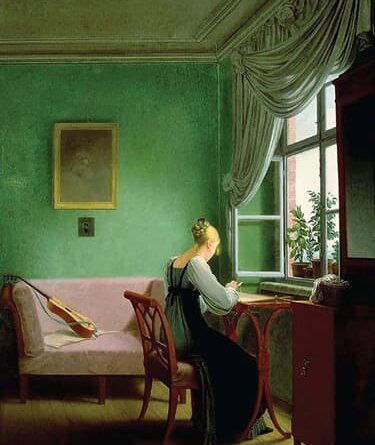When the Walls Were Painted With Poison
It was a verdant, ferny hue — hint of forest, flash of emerald — a vegetal contrast to the foggy mists and factory-smudged skies of England at the pitch of the Industrial Revolution.
The color — Scheele’s Green, named for the Swedish chemist who invented it in 1778 — was everywhere in Victorian England, from the walls of Buckingham Palace to the factories where child laborers painted the leaves of fake foliage. The hue showed up in paint and book-bindings, in candy and cake decorations, in clothing and children’s toys.
The vibrant shade was the Brits’ “it” color of the 19th century. It was everywhere. And it was deadly.
Scheele’s Green was made by blending copper and oxygen with arsenic, an element that may be found naturally in the earth’s crust, oceans, and groundwater. Victorian-era physicians prescribed arsenic to treat fever, asthma, and eczema. Today, arsenic trioxide is an effective chemotherapeutic drug for acute promyelocytic leukemia.
But for centuries, people knew that arsenic had toxic — even lethal — potency. Sometimes called “the king of poisons and the poison of kings,” arsenic became a popular way to discreetly dispose of royal rivals. It was easy to obtain, odorless and tasteless, and the immediate symptoms of acute arsenic poisoning — nausea, vomiting, diarrhea, and abdominal cramps — could be attributed to cholera or other common diseases of the time.
As early as 1839, a German chemist warned his countrymen that damp rooms swathed in the alluring Scheele’s Green could produce a toxic acid within the walls. Soon after his report, published in the daily newspaper Karlsruher Zeitung, four children in London died of respiratory distress; their room had recently been papered in green. Tests on the wallpaper showed 3 grains of arsenic per square foot, a lethal dose.
Other deaths and illnesses were traced to the arsenic-laced hue, including the nightly distress of a Birmingham physician who suffered cramps, light-headedness, and an overwhelming urge to vomit after spending time in his green-papered study. He concluded, “A great deal of slow poisoning is going on in Great Britain.”
But green wallpaper was a robust business. The designer William Morris, whose popular wall-covering patterns used the vibrant dye, also owned shares in his father’s mining company, the largest producer of arsenic at the time. He scoffed at the arsenic scare, declaring that doctors who cautioned against the chemical “were bitten as people bitten by witch fever.”
What actually happens in a human body exposed to arsenic depends largely on the dose, says Michael J. Kosnett, associate adjunct professor in the Department of Environmental and Occupational Health at the Colorado School of Public Health.
A high dose triggers gastrointestinal symptoms followed by low blood pressure and heart arrhythmias. If a person survives that bodily insult, the next few days may bring plummeting white and red blood cell counts, followed by peripheral neuropathy — pain, tingling and eventually numbness and weakness in the hands and feet.
“People who died of acute arsenic poisoning — a dose high enough to kill you within hours — died of fluid loss and shock that led to cardiovascular collapse,” Kosnett says.
But arsenic also causes long-term damage, multisystemic erosion that Victorian-era physicians and patients would not have been likely to trace to close brushes with Scheele’s Green.
Arsenic causes skin cancer, lung cancer, and bladder cancer; it may also contribute to liver and kidney cancers. “And there’s a whole panoply of noncancer effects at a sufficient dose,” Kosnett says. “There are associations with hypertension, cerebral vascular disease, and diabetes. There is also emerging evidence that arsenic may contribute to adverse reproductive outcomes and neurocognitive development.”
What 19th-century observers did notice — and documented, in medical textbook illustrations, lurid newspaper stories, and the occasional cautionary cartoon — were the hyper-pigmentation and physical deterioration that resulted from exposures to inhaled or ingested arsenic. One drawing, from an 1862 edition of Punch, depicted “The Arsenic Waltz,” a skeleton dressed in rail-thin slacks and tailcoat bowing to another skeleton, a woman wasting away inside the bell-shaped skirt of her gown.
In 1879, when a visiting dignitary to Buckingham Palace became ill after sleeping in the green-wallpapered guest chamber, Queen Victoria ordered that the paper be stripped from the palace’s walls. By the time the British government got around to regulating arsenic in food in 1903 (they never officially banned it in household goods), the public — spurred by newspaper accounts of the ill effects of Scheele’s Green — had already backed away from products tainted by the chemical.
Manufacturers developed safer dyes, though even today’s commercial greens are less than perfectly ecological; they’re made with chlorine, which can’t be recycled or composted safely. The thirst to mimic nature’s fecund palette, to conjure an Edenic green, to bring the outside in, remains unquenchable … and problematic.





pin up casino: https://pinupgiris.fun/ pin-up giriş